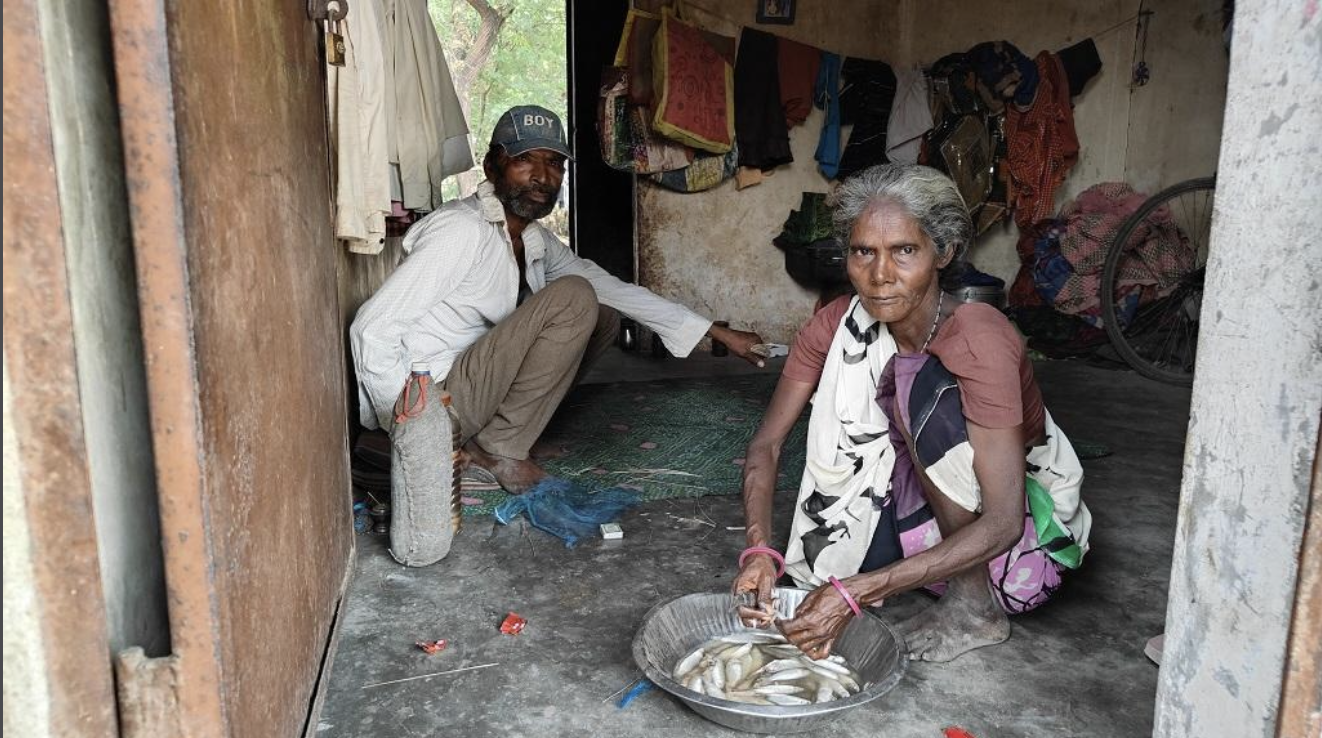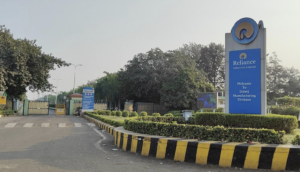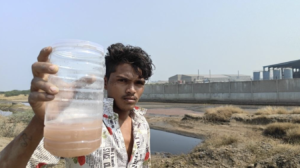Industrial pollution has destroyed local fisheries in the Gujarat port, with fisherfolk forced to seek work in the units they sold their lands to.
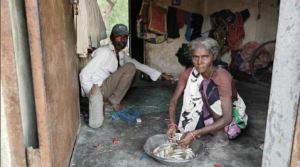 The lives of people in many areas of Gujarat have become difficult due to petrochemical industries. At the same time, climate goals are being impacted due to pollution caused by these industries. This the first part of this series. Read the second part here.
The lives of people in many areas of Gujarat have become difficult due to petrochemical industries. At the same time, climate goals are being impacted due to pollution caused by these industries. This the first part of this series. Read the second part here.
“The salty water of the sea and the competition to catch the fish in it. Big fishers used to catch up to 20, 30, 40 kilograms (kg) of fish daily then. Even small fishermen could catch 5-10 kg of fish. Those were happy days. Child education, marriages, building houses — everything used to depend on these fish. Now, there are no fish in the sea. Because now, the sea water is not as clean as before,” Gumaanbhai Jaisinh Rathod’s voice trailed off with a note of disappointment as he spoke to this reporter.
He opened his arms wide, “Earlier, there used to be such big fish in the sea. I caught them myself. The fishers would happily return home then. Today, we get small-sized fish. Hardly 1-2 kg. Like vegetables. We sell it or eat it ourselves. What will a fisherman earn by catching one or two kilos of fish every day?”
“I have been fishing since childhood. I don’t know my age. But I have got a son and a daughter married. The fish has gone since the arrival of these companies. They release so much chemicals in the sea that you will not be able to breathe there. Industrial effluent spreads into the sea. This kills all the fish and crabs,” Rathod added.
Rathod belongs to a Scheduled Tribe community of Dahej in Vagra taluka of Gujarat’s Bharuch district. The port of Dahej is located near the site where the Narmada river discharges into the Gulf of Khambhat through a broad estuary.
Dahej is one of several villages in the area where local lives have changed for the worse due to industrial expansion. Many villages in Bharuch district, including Dahej, Suwa, Lakhigam, Kavi, Sarod, Hansot, and Kantiazar, have traditionally depended on fish farming for livelihood.
Meteoric Rise
The state of Gujarat has the longest coastline in the country at 1,600 km and an Exclusive Economic Zone covering an area of 0.214 million square kilometres. Gujarat had 36,980 boats in 2021-22 and 0.218 million fishers according to the 2007 state census.
Dahej began to be developed as a Special Economic Zone (SEZ) in 1990. Industrial cities in Gujarat such as Surat and Vadodara had become saturated with industrial units.
Dahej is located near the ancient port site of Barygaza (near today’s Bharuch) on the Gulf of Khambhat, which had trade links with west Asia, in addition to western and southern India. This made it an ideal location for an industrial port.
Over time, Barygaza went into oblivion due to geographical and maritime changes. But with the formation of the SEZ, many big industrial houses like Reliance, Birla, ONGC, Torrent and Adani set up their enterprises in Dahej and it became a big centre of the petroleum, chemical and petrochemicals industries.
In April 2007, the Government of India announced the Petroleum, Chemical and Petrochemicals Investment Region (PCPIR) Policy and allowed four PCPIRs for the purpose of developing industrial corridors in the country. The Dahej PCPIR is the only active PCPIR in the country in terms of investment, infrastructure development, exports and employment.
Dahej PCPIR covers 453 sq km across 44 villages of Vagra and Bharuch talukasin Bharuch district. Dahej — comprising 180 existing and 650 under-construction industrial units — has attracted an investment of over Rs 1 lakh crore, according to the performance analysis of Dahej PCPIR published in the Journal of Emerging Technologies and Innovative Research in 2020.
It is the fastest growing PCPIR in India, with petrochemical products like polymer, polythene, polypropylene, benzene, butadiene, pyrolysis gasoline.
As these enterprises grew, the dreams and incomes of locals like Rathod, settled in the villages here, dwindled.
Increasing pollution, decreasing fish
There is anger in the voice of young Kartik Rathod, who is disentangling a fishing net with Gumaanbhai. The 21-year-old youth has grown up at the same time as the whirlwind pace of industrial development in Dahej. He talked about how, during this period, he saw the stench of chemicals increase in the air, the sea water become turbid and the fish decrease.
“I studied up to Class IX. Then I started fishing in the sea with my father. Earlier, we used to get so much stock that we could make up to Rs 500-1,000. But now, we hardly get even Rs 100-200. Industrial units release chemicals into the sea from big pipes. There is so much pollution that you cannot stand at one place. But we have to go into the water. I have rashes all over my body and suffer from itching. Even the fish smell of chemicals,” said Kartik.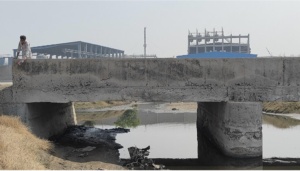
The Dahej PCPIR is expected to provide direct employment to about 32,000 people. On the question of jobs for locals, Kartik said, “The units do not employ us on a monthly basis. They call us to work only when they have a requirement and give us Rs 350 a day. They does not give us jobs and their chemicals have also killed the fish in the sea. If the government stops the release of chemicals, maybe our fishing business will benefit.”
Many other youngsters, women and elderly fishermen in Dahej share similar problems.
Dahej is important environmentally as the freshwater of the Narmada enters the saline waters of the Gulf of Khambhat. Many types of fish and sea life including shrimp, bumla, salmon, boi, makul are found here. At the same time, the area is also the breeding ground of the Hilsa (known as ‘palwa’ in Gujarat) fish. The economy of many villages depends on it.
Rivers and seas have become easy means of disposal of industrial waste. Kartik and his colleagues show the spot near the village where polluted water from an industrial unit was moving towards the sea. One could feel the pungent suffocating smell of chemicals in the air, along with the foul smell of this highly polluted red-and-black coloured water. A school van passes through this route.
The young fishermen said, “When such poisonous water is found in the sea, how will the fish survive? We live in such a climate.” According to a research report on industrial pollution in the coastal areas of Gujarat, Where did the fish go, the number of fish caught from the sea has decreased in the last 10-15 years with the increase in industrial units.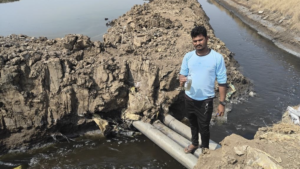
The Gujarat Pollution Control Board (GPCB) office in Bharuch is manned by six laboratory and five technical staff. They are responsible for controlling pollution in the Dahej PCPIR spread over 453 sq km.
Kishore Waghmashi, deputy environment engineer at the board’s office in Bharuch, said, “We constantly monitor industrial units, conduct surprise inspections and try to implement the standards set for the environment. Financial penalties are also imposed on units for violating the rules. We also have to work on solving the problems of the industry association.”
The Gujarat Ecology Commission, in its environmental strategy for development and conservation of natural resources for the year 2014-2019, found Bharuch district to be critically polluted in terms of industrial waste and admitted that the data related to industrial waste is vague and inadequate.
How effective this strategy has been can be gauged from a petition filed in the National Green Tribunal (NGT) regarding the pollution of industrial units in Dahej in 2022. The committee, set up on the orders of the NGT, found in its investigation that many industries are discharging contaminated water without treatment. The committee, in its multiple inspections, found that untreated wastewater was being discharged into the deep sea. In many inspections, the companies were found secretly discharging contaminated water. No scientific investigation was done to assess the damage caused to the local environment. GPCB issued show cause notices to some industrial units. But no corrective action was taken.
According to the rules, the contaminated water of industrial units has to be release 4 km into the deep sea after treatment from an Effluent Treatment Plant (ETP). But the Gujarat Industrial Development Corporation’s (GIDC) pipeline to carry wastewater to the sea has been damaged since 2018. This was revealed during the hearing in the NGT. Digant K Lad, executive engineer at GIDC Bharuch, said a new pipeline is being laid out and this work is expected to be completed by October 2024. That is, industrial wastewater is being released on the seashore since 2018.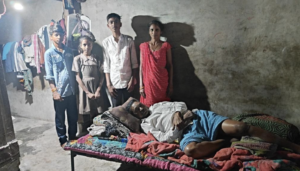
Till about one-and-a-half years ago, the manhole system was also being used to drain out contaminated water. “We found in our investigation that many industrial units used to discharge wastewater directly into the ground without treating it. Therefore, in the last one-and-a-half years, we closed the drainage network through manholes and laid pipelines above the ground. We built a pumping station near 10-12 companies. Dahej PCPIR has 29 pumping stations as of now. After treatment from here, all the pipes go to a common ETP from where, they are put out to sea,” Digant said.
He did not deny that despite all this, companies do contaminate water at night or secretly.
From owners to labourers
Industrial pollution in the Dahej PCPIR area has had a direct impact on the traditional ways of livelihood of the local community. Youngsters like Kartik are struggling with the traditional fishing profession. On the other hand, there are many youngsters who — having trained at ITI post-matriculation — are preparing to get a job in the same industries that have changed their area forever. This is a priority for the educated youth of this area. These jobs are on contract. So there is a risk of being fired anytime.
Vishnu of Suva village in Vagra taluka, adjacent to Dahej, has also taken ITI training. But being 17 years old, he has not got an opportunity for apprenticeship yet. He has to take over the financial responsibility of the family soon. Vishnu’s father used to work in a chemical factory. Excessive alcoholism damaged his liver and he became bed-ridden. Vishnu’s mother Jashodaben works as a cleaner in a factory and puts food on the table.
Vishnu said jobs are not easily available for locals in the companies. But those who try, do get work.
Vishnu’s neighbor, Hiral, has also trained at ITI and has been working in a chemical company on contract for the last 10 years. “Even after working for 10 years, my salary is just Rs 15,000 per month,” he complained.
Industrial pollution is leading to traditional self-employment being lost and there is stiff competition in jobs. Kamlesh S Madhiwala, a lawyer and president of the Bharuch District Machhimar Samaj, a non-governmental organisation, said, “Locals are now working as labourers in the same companies to which they had once given their lands. No company gives a salary of more than Rs 10, 20 or 25,000 salary to the educated youth here. Whereas a good fisherman in the fishing business used to earn up to Rs 10-15 lakh in a year. Even an ordinary fisherman used to earn up to Rs 4-5 lakh. The youth are compelled to work in these companies.”
Local people are struggling for livelihood and the graph of profits of industrial units is constantly on the upward trend. The value of the country’s chemical industry is projected to grow from $220 billion in 2022 to $300 billion by 2025.
The traditional means of livelihood of the community living in Asia’s number one industrial region are shrinking and new industrial units are emerging rapidly. The GPCB gave environmental clearance based on the study from December 2021 to February 2022 to develop industrial parks and multi-product SEZs in a 715-hectare area spread over Pakhajan, Ambhel and Limdi villages of Vagra taluka.
(This story is part of a fellowship granted by the Centre for Financial Accountability)
Read this article in Hindi here.
This article was originally published in Down To Earth and can be read here.
Centre for Financial Accountability is now on Telegram and WhatsApp. Click here to join our Telegram channel and click here to join our WhatsApp channel and stay tuned to the latest updates and insights on the economy and finance.

